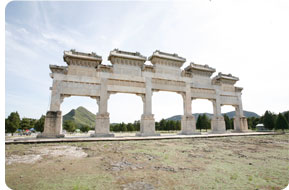 The Eastern Qing Tombs locate in zunhua Town, Hebei Province, the boundary is in peking, Tangshan, Chengde and Qinhuangdao. The west is apart from 125 kilometers of Peking, the south is apart from 150 kilometers of Tientsin, the southeast is apart from 100 kilometers of Tangshan, the north is apart from 100 kilometers of Chengde. It is among the finest and largest tomb complexes in China which maintain it is complete and best preserved. Here, 161 emperors, empresses, concubines, princes and princesses are buried in altogether 15 mausoleums, which cover an area of 80 square kilometers. The Eastern Qing Tombs locate in zunhua Town, Hebei Province, the boundary is in peking, Tangshan, Chengde and Qinhuangdao. The west is apart from 125 kilometers of Peking, the south is apart from 150 kilometers of Tientsin, the southeast is apart from 100 kilometers of Tangshan, the north is apart from 100 kilometers of Chengde. It is among the finest and largest tomb complexes in China which maintain it is complete and best preserved. Here, 161 emperors, empresses, concubines, princes and princesses are buried in altogether 15 mausoleums, which cover an area of 80 square kilometers.
According to the Feng Shui theory, or the natural topographical features of the area, the Eastern Qing tombs site is indeed an ideal one of imperial mausoleum. It has Chang Rui Mountain in the north like a natural screen, Jin Xing Mountain in the south like an official who holds document in his hands standing in front of the mausoleum, the Ying Bi Hill lying between Chang Rui Mountain and Jin Xing Mountain just like a table, in the East, the steep and stiff Ying Fei Dao Yang Hill faces westward, serves as the left supporting hill. In the west, Huang hua cliff, facing eastward. Serves as the right supporting hill. There are two rivers in the east and west criss-crossing in the mausoleum and then flow out of the natural exit of the mausoleum area, A broad and flat land is surrounded by mountains and rivers, This is really a precious place by the standard of geomancy theory. It was said that the first Qing Emperor Shunzhi himself selected this site when he once went hunting here.
In the grand imperial tomb area are many exquisite buildings. They represented the highest architectural and artistic level at that time. The Stone Archway, a five-opening, six-pillar and 11-roof building, is the widest one extant in China. The 6000-meter long main sacred way in Xiao ling Tomb remains intact, the underground palace of Yu ling Tomb, with many exquisite and vivid carvings on Buddhism, has been known as “solemn underground Buddhist Hall”, The three halls of CiXi’s Tomb are known for their gold-glazed colored painting. Their extremely luxurious decoration is rarely seen in the world; The stone block carved with a phoenix above a dragon is vivid and life like……
Now the Eastern Qing Tombs have a history of more than 300 years, Each tomb has its own history, either rising or declining. Each tomb carries some moving or mysterious stories about the owners. Among 161 people buried here many were very much influential in the history. There are, for instance, Emperor Shun zhi, the first emperor who entered the Shanhaiguan Pass and made Beijing their capital; Emperor Kang Xi who created the booming period of Kang Xi and Qian Long; Emperor Qian Long who lived and held the actual supreme power for the longest period of time in China’s feual society; the famous woman politician Empress Xiao Zhuang wen who assisted two young emperors Shun Zhi and Kang Xi; Empress Dowagers Ci’an and Ci xi who ruled the country behind the curtain; Xiang fei (perfume consort) who gave people a sense of mystery,….. The main figures buried in the Eastern Qing Tombs witnessed more than half of the Qing Dynasty, presenting very rich historical information.
Just because of their indisputable charm and their great historical, artistic and scientific value, the Eastern Qing Tombs was inscribed into the World Heritage list on Nov, 30, 2000, and was appraised as AAAA scenic spot by the state Travel Bureau in Jan. 2001. |

